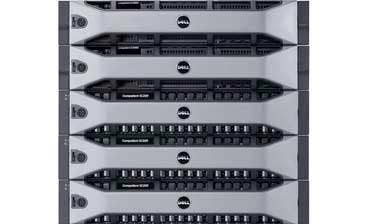Dell Compellent Auto-Tiers Data Between SLC, MLC Flash For High-Performance, Low-Cost Storage

Dell on Tuesday officially started shipping Compellent storage systems with what it bills as the industry's first intelligent tiered flash storage technology, a move aimed at improving flash performance while bringing the cost down to hard drive levels.
The new tiered flash technology, first unveiled in June at the Dell Enterprise Forum, combines high-speed SLC flash memory with slower but cheaper MLC flash memory, said Bob Fine, director of product marketing for Dell storage.
[Related: Head-To-Head: Dell Venue 11 Pro Vs. Microsoft Surface Pro 2 ]
Dell then applies its Data Progression auto-tiering software to automatically tier data between the SLC and MLC flash memory and to hard drives, Fine said.
"When data comes at it, it is steered to SLC for the best performance in writes," he said. "The data is then moved to MLC flash, as the read performance of MLC is on par with SLC. It's unique. No one else has it."
The result is a high-performance storage array priced under traditional arrays using high-performance 15,000-rpm hard drives, Fine said.
He gave the example of an all-flash Compellent array with six SLC SSDs and six MLC SSDs providing 12-TB capacity at a cost of about $180,000. To get 12 TB of high-performance disk storage, a company would have to purchase 82 146-GB 15,000-rpm hard drives for a total cost of $229,000.
And, Fine said, the all-flash solution requires significantly less rack space and power while providing higher performance than the disk solution.
Paul Clifford, president of Davenport Group, a St. Paul, Minn.-based solution provider and longtime Dell Compellent partner, said he did a Friday presentation of the new Dell Compellent combined MLC-SLC flash memory to a group of customers.
"When I finished, I asked, do I have an Amen? I got a resounding Amen," Clifford said.
Other all-flash storage array vendors like Nimble Storage and Tegile have done a good job of providing raw I/Os per second (IOPS) using all-MLC flash technology, Clifford said.
"But they aren't doing what Dell's doing," he said. "It's all about data placement. What Compellent has always done with its architecture is put data in the right place at the right time. And what no one else -- and I emphasize no one -- does is move the data when and where it's needed."
NEXT: Exploring The Technology Behind MLC/SLC Flash Auto-Tiering
Other vendors like EMC offer all-SLC flash memory for their high-performance storage, Davenport's Clifford said.
"But look at an email with a 2-KB header and a 1-MB PowerPoint attachment," he said. "Dell Compellent ingests it into SLC flash, and then can move to MLC flash any time. Why? Because MLC handles reads at the same performances as SLC. So why use the SLC to do what MLC can do?"
The typical approach to high-performance storage is to add a relatively small amount of flash memory to a disk-based storage array to increase performance without adding significantly to the cost, said Rick Gouin, CTO at Winslow Technology Group, a Boston-based solution provider and longtime Dell Compellent partner. Dell instead has gone the path of reducing the cost of flash storage, Gouin said.
"As the gap between the cost of flash and the cost of hard disk storage closes, flash can be used for larger storage pools," he said. "Dell has looked hard at that, and has made flash sold today stay relevant in the future as prices come down."
The technology for tiering between SLC and MLC flash happens because of how Dell Compellent's Data Progression tiering software was architected from the beginning, Gouin said.
"The real difference with Date Progression is it can tell the difference between reads and writes and can send data to wherever is best," he said. "For instance, in the past, Data Progression working on all-disk arrays might send data writes to RAID 10 and reads to RAID 5. This is an extension of that architecture, only writes are sent to SLC flash and reads to MLC."
Gouin said Winslow Technology has already priced out a few storage solutions with the tiered flash technology to customers and is seeing a lot of interest.
"We've found a couple of applications perfect for this," he said. "The best fits are the ones with high-density I/O profiles. Large workloads with thousands of IOs per second, but not necessarily with huge capacities."
Dell on Tuesday also started shipping its SC280 high-density disk enclosures for its Dell Compellent arrays. The SC280 puts over 80 4-TB, 3.5-inch SAS hard drives, or up to 336 TB of raw capacity, in a 5U enclosure, Dell's Fine said.
"This changes the capability for offering storage density," he said. "For instance, for big data, customers need it injected fast and stored efficiently. In all those aspects, we're changing the economics of storage."
PUBLISHED OCT. 8, 2013